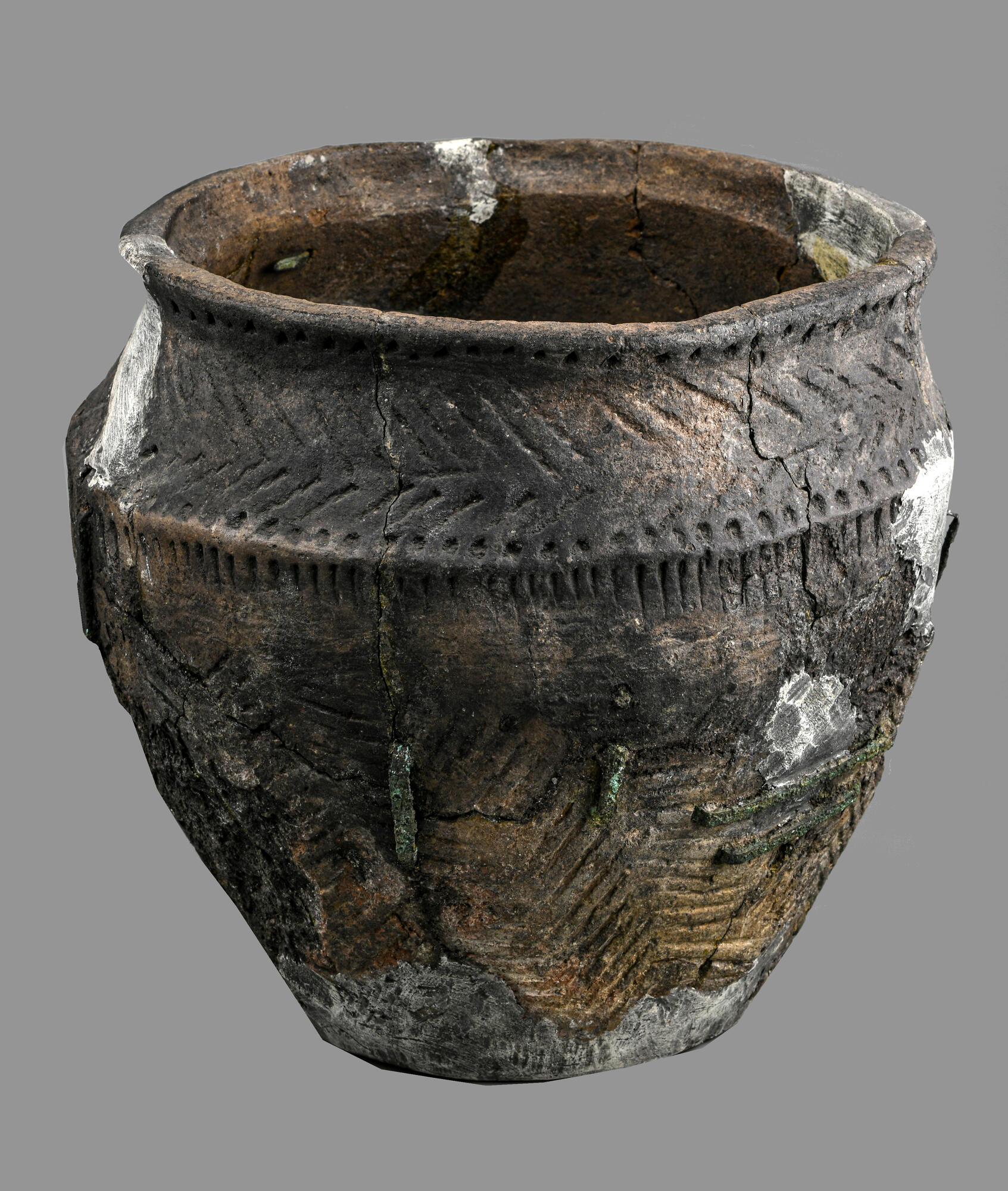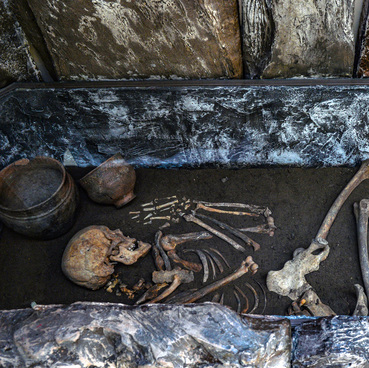The cultures of this time in our region are not associated with the preceding Eneolithic layer. In archeology, this period was called the Bronze Age, whose consistent development fully reflects the sections of our exposition.
In 1973, near the Tractor Trailer Plant, archaeologists uncovered the 25th burial mound of Novokumak Graveyard. It was these materials that opened the burials (12,13,14) of the belligerent nation of the catacomb culture, who in the early Bronze Age invaded from the south and cleaved apart the tribes living in the western areas of our region. The culture was named after the shape of the burial structures in the form of burial wells or catacombs. The dead were buried in a well or a chamber, the entrance to which was covered with stone slabs, in a bent position, sputtered with red ochre. There are not too many monuments of this time in the Southern Urals.
The materials of the Novokumak Graveyard also became the basis for revealing the components of a surprisingly bright layer of Sintashta cultural monuments, a characteristic feature of which was the presence of fortified settlements, called the ‘Land of Cities’ Among them, the fortified settlements of Arkaim, Sintashta and Aland are widely known.
There are no such settlements on the territory of our city, but in the 25th mound of Novokumak burial ground, 6 inlet burials of Sintashta time were found.
The population of Sintashtan culture was primarily Europoid, and was engaged in copper ore mining, metallurgy and metalworking, ceramics, leather and weaving. However, animal husbandry was the backbone of their daily lives. The herd was mainly composed of small and large cattle, horses and two-humped camels. Horse breeding was aimed at nurturing speed and endurance in them (Koryakova L.N., Epimakhov A.V. 2010). Since the Sintashtans had to live in a difficult, restless time, in order to protect their cattle and their copper mines, they created monumental protective structures in the form of a closed complex with clay walls up to 5.5 meters thick and 3.5 meters high, with square, radial or perpendicular streets.
Sintashtans learned to train horses and harness them in a two-wheeled wagon, inventing war chariots. It is quite possible that thanks to these chariots they controlled a huge territory, taking livestock from their neighbors (Grigoriev S.A., 2000 p. 280).
For an unknown reason, the Sintashtans left their cities and moved south.
In 1973, near the Tractor Trailer Plant, archaeologists uncovered the 25th burial mound of Novokumak Graveyard. It was these materials that opened the burials (12,13,14) of the belligerent nation of the catacomb culture, who in the early Bronze Age invaded from the south and cleaved apart the tribes living in the western areas of our region. The culture was named after the shape of the burial structures in the form of burial wells or catacombs. The dead were buried in a well or a chamber, the entrance to which was covered with stone slabs, in a bent position, sputtered with red ochre. There are not too many monuments of this time in the Southern Urals.
The materials of the Novokumak Graveyard also became the basis for revealing the components of a surprisingly bright layer of Sintashta cultural monuments, a characteristic feature of which was the presence of fortified settlements, called the ‘Land of Cities’ Among them, the fortified settlements of Arkaim, Sintashta and Aland are widely known.
There are no such settlements on the territory of our city, but in the 25th mound of Novokumak burial ground, 6 inlet burials of Sintashta time were found.
The population of Sintashtan culture was primarily Europoid, and was engaged in copper ore mining, metallurgy and metalworking, ceramics, leather and weaving. However, animal husbandry was the backbone of their daily lives. The herd was mainly composed of small and large cattle, horses and two-humped camels. Horse breeding was aimed at nurturing speed and endurance in them (Koryakova L.N., Epimakhov A.V. 2010). Since the Sintashtans had to live in a difficult, restless time, in order to protect their cattle and their copper mines, they created monumental protective structures in the form of a closed complex with clay walls up to 5.5 meters thick and 3.5 meters high, with square, radial or perpendicular streets.
Sintashtans learned to train horses and harness them in a two-wheeled wagon, inventing war chariots. It is quite possible that thanks to these chariots they controlled a huge territory, taking livestock from their neighbors (Grigoriev S.A., 2000 p. 280).
For an unknown reason, the Sintashtans left their cities and moved south.


